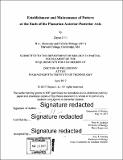Establishment and maintenance of pattern at the ends of the planarian anterior-posterior axis
Author(s)
Li, Dayan J
DownloadFull printable version (17.86Mb)
Other Contributors
Massachusetts Institute of Technology. Department of Biology.
Advisor
Peter W. Reddien.
Terms of use
Metadata
Show full item recordAbstract
How cellular and molecular processes are orchestrated to generate complex tissues and anatomical patterns is a longstanding question in biology. Planarians, flatworms capable of remarkable whole-body regeneration, are well suited for the study of patterning. They are adept at establishing pattern in new tissues during regeneration and maintaining pattern of existing tissues during homeostasis. We focused our study of patterning along the planarian anterior-posterior (AP) axis spanning the head and the tail. Located at the ends of the AP axis are the anterior and posterior poles. As putative organizers, the anterior and posterior poles are regions defined by their expression of genes required for head and tail patterning, respectively. Using transplantation, we tested the organizing activity of the head tip region containing the anterior pole and demonstrated its ability to induce outgrowths containing a new AP axis and a midline. Furthermore, we studied the formation of the anterior pole during regeneration and determined that its location is set by three landmarks in pre-existing tissue - a polarized AP axis, the midline, and the dorsal-ventral median plane. By organizing regenerating tissue around a location determined by preexisting tissue, the anterior pole links existing positional cues to the establishment of new pattern. To better understand pole function, we characterized the anterior and posterior pole transcriptomes by RNA sequencing. We identified several new genes highly expressed in the poles, including ones encoding transcription factors, cell surface receptors, and a secreted factor produced by both poles. Among them was nr4A, a nuclear receptor gene predominantly expressed in the body-wall muscle and found to regulate the expression of other muscle-enriched genes. Inhibition of nr4A during homeostasis resulted in both head and tail patterning defects characterized by a posterior shift of the anterior pole and an anterior shift of the posterior pole. This was accompanied by similar changes in the expression domains of head and tail patterning genes, and was followed by loss of muscle fibers at the head tip and the appearance of ectopic differentiated tissues normally restricted to the head and tail tip periphery. These results identified nr4A as a new planarian patterning gene that maintains head and tail identities, as well as anterior and posterior pole locations, at the ends of the planarian AP axis.
Description
Thesis: Ph. D., Massachusetts Institute of Technology, Department of Biology, 2017. Cataloged from PDF version of thesis. Includes bibliographical references.
Date issued
2017Department
Massachusetts Institute of Technology. Department of BiologyPublisher
Massachusetts Institute of Technology
Keywords
Biology.